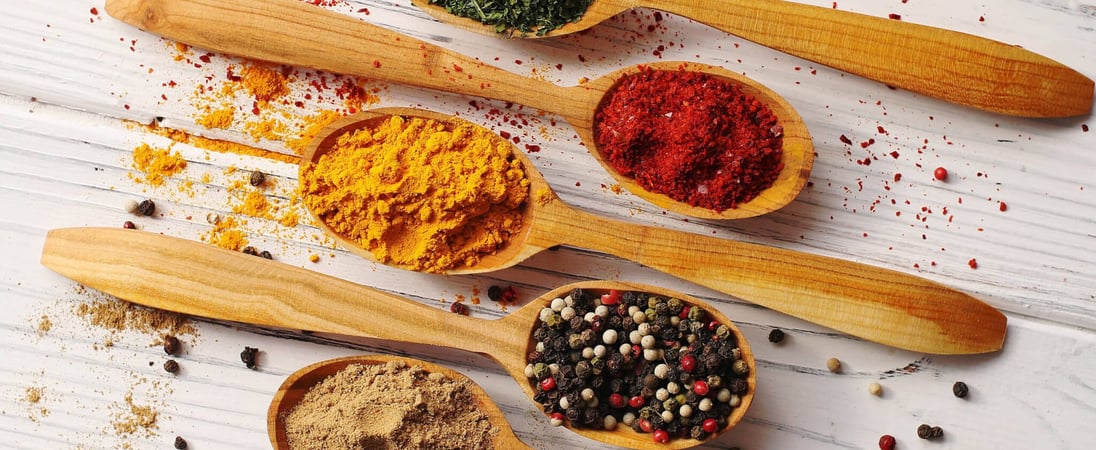
Za’atar Day
Make your own blend of the za’atar herb (a type of thyme) and other spices and enjoy some za’atar-based foods and new cuisines with friends or family.
You may never have heard of the word ‘Za’atar’ before, but we think it’s time that you definitely get to know it! This is a term that is used to describe a culinary herb.
It is also used to describe a spice blend that people use as a condiment, especially in Middle Eastern cuisines, containing the herb itself, as well as salt, dried sumac, toasted sesame seeds, and other spices. Is your mouth watering yet? It certainly adds heaps of flavor to any sort of meal!
You pronounce Za’atar as zah-tar. It is a type of wild thyme, which is native to the Middle Eastern and Levantine Region. It is used to make the Za’atar blend, which we touched upon in the introduction. It is probably one of the world’s most versatile spices and condiments.
The blend is multi-purpose, as it has a tangy, savory taste, with a kick as the after bite. Because of this, it is used in a wide range of ways.
A lot of people add it to olive oil for a delicious yet simple dip. It can also be used to add to baba gannouj, hummus, and labne, which is a thick cream made from yogurt. A lot of people also add it to salad dressings, roasting and sauteed vegetables, eggs, and chickpeas.
Or, you can use it as a rub for fish, meat, and chicken! As you can see, there really is no limit when it comes to the way that this versatile ingredient can be used! The great thing about Za’atar is that it can make plain food taste incredible.
This is probably why the most popular use for the blend is to mix it with olive oil and use it as a topping for mankoushe, which is a traditional Middle Eastern baked bread. If you’re wondering how to pronounce this bread, it is man-ou-sheh.
How To Celebrate Za’atar Day
Aside from making your own Za’atar blend, there are a number of ways that you can observe Za’atar Day. Why not gather your friends and loved ones and cook a meal that contains Za’atar?
As mentioned earlier, there are plenty of different ways that you can use this spice blend! It can be present in everything from the dips you serve to the meat you put on people’s plates. One dish that is easy and is bound to go down a treat is Za’atar roasted chicken.
All you need to do is roast the chicken in the manner you usually would, yet cover it with the spice blend so that it is bursting with flavor! Don’t forget to serve some baked Middle Eastern bread with olive oil and Za’atar for the full effect!
Another way to celebrate Za’atar Day is to make your own healthy skin paste. There are so many DIY recipes for skin products on the Internet today, and with the inflammatory properties that are associated with Za’atar, this would certainly make a good ingredient.
You are bound to find plenty of different ideas online regarding this, so have fun exploring the different options out there.
In an ode to Za’atar, you could also have fun attempting to create your own spice mix! We are sure you probably have some different herbs and spices in your cupboards, so why not get experimental and see if you can create something as delicious as Za’atar?
You never know, you may end up coming up with your own secret mix that everyone wants to know the recipe for!
How To Make Your Own Za’atar Blend
Of course, the best way to celebrate Za’atar Day is to make your own homemade spice blend. We’ve got a recipe to help you out with this…
Ingredients
- ¼ teaspoon or more of Aleppo chili flakes – it all depends on how much of a kick you like!
- ½ teaspoon kosher salt
- One tablespoon of sumac
- One tablespoon of toasted sesame seeds
- One tablespoon of ground coriander
- One tablespoon of ground cumin
- One tablespoon of dried thyme, which has been crushed
Directions
- Grab a small bowl, and mix all of the ingredients together.
- Simply store it in an airtight container.
- For the best flavor, you should toast the whole seeds of coriander and cumin until they are fragrant, and then grind them. However, if you do not have whole seeds, you can simply substitute them for ground spices.
Learn about the health benefits of Za’atar
Not only does Za’atar taste amazing, but it has a number of health benefits as well. This includes the following:
-
Strengthen bones
The first health benefit that is associated with Za’atar is that it can help to strengthen your bones. One thing that all of these herbs have in common is minerals. Therefore, between the high concretion of magnesium, copper, calcium, and iron, Za’atar can have a big impact on the density of your bone minerals.
-
Improve mood
Studies have shown that there are links between Za’atar and decreased rates of depression and heightened mood.
-
Increase energy
You will also notice that you get a powerful energy boost from Za’atar. It can get your metabolism moving because of the high concentration of flavonoids and polyphenols that are found within the spice mix.
-
Soothe inflammation
Za’atar can also help to soothe inflammation. You can actually use it as a paste for your skin, rather than consuming it as a food. Putting it on inflamed areas of the skin, such as aching joints and bug bites, can have an effect that is similar to an anti-inflammatory effect.
-
Clears respiratory tract
There are a number of expectorant properties of thyme. It can help to clear the respiratory tracts, which will cause you to cough out mucus and phlegm. This makes it an excellent food to add to your diet if you feel a cold coming on.
-
Relief from chronic disease symptoms
Last but not least, Za’atar acts as an antioxidant, protecting the body against free radicals that are responsible for a number of different health conditions.
Za’atar Day FAQs
How did za’atar influence ancient Middle Eastern trade routes?
Za’atar, like many spices, played a role in ancient trade. The Levant was a crucial stop on spice routes connecting Asia, Africa, and Europe.
Traders valued za’atar for its culinary and medicinal uses, exchanging it for precious goods like silk and frankincense.
Some records suggest that za’atar blends were carried by travelers for their long shelf life and supposed health benefits.
What’s the connection between za’atar and religious rituals?
Za’atar appears in biblical references, often linked to purification rituals.
Some scholars believe the “hyssop” mentioned in religious texts is a variety of wild thyme, a key ingredient in za’atar.
Ancient Jewish traditions included za’atar in temple offerings, while some Christian monks used it in herbal remedies for spiritual cleansing.
Can za’atar affect mood and mental health?
Thyme and oregano—two primary ingredients in za’atar—contain carvacrol, a compound linked to mood enhancement.
Studies suggest carvacrol increases dopamine and serotonin levels in the brain. This may explain why people feel uplifted after consuming za’atar, making it not just a flavorful spice but also a natural mood booster.
What’s the role of za’atar in Middle Eastern hospitality?
Serving za’atar is an act of hospitality in many Middle Eastern homes. When guests arrive, they’re often welcomed with fresh bread, olive oil, and za’atar.
It’s a symbol of warmth and generosity, much like offering tea in some cultures. In some regions, families even gift homemade za’atar blends to visitors as a token of friendship.
How did za’atar inspire Middle Eastern poetry and literature?
Za’atar has been praised in Middle Eastern poetry for centuries. Classical Arab poets often compared its aroma to the freshness of spring or the sweetness of a lover’s breath.
Palestinian poet Mahmoud Darwish referenced za’atar as a symbol of home, resistance, and cultural identity.
The spice’s deep roots in literature reflect its emotional connection to heritage and nostalgia.
Why do some people say za’atar “tastes like the land” of the Levant?
The plants used in za’atar grow in the Mediterranean’s rocky, mineral-rich soil.
This terroir gives the spice a unique earthy taste that reflects the Levant’s natural landscape. Farmers often describe its flavor as “the scent of the hills after rain.”
Many believe eating za’atar is a sensory link to the land itself, making it more than just a seasoning.
Is there a “perfect” way to store za’atar?
Za’atar lasts longest when stored in an airtight glass container away from light and heat.
Some families keep their mix in olive oil, which not only preserves it but also enhances its flavor over time.
Unlike many spices, za’atar improves with age when stored properly. However, exposure to moisture can cause it to clump, reducing its potency.
How do modern chefs experiment with za’atar?
Chefs worldwide have embraced za’atar in creative ways. Some infuse it into ice cream, blending its herbal notes with creamy textures.
Others use it in cocktails, pairing it with gin or citrus-based drinks.
Even high-end restaurants have introduced za’atar-crusted sushi, showing how this ancient spice continues to evolve in contemporary cuisine.
What is “forbidden za’atar,” and why is it controversial?
In some areas, wild za’atar harvesting has been regulated or banned to prevent overharvesting.
In Israel, picking wild za’atar has been restricted since the 1970s due to conservation concerns.
Despite this, many foragers continue the tradition, sometimes facing fines. The restrictions have sparked debates about cultural heritage versus environmental responsibility.
What are some lesser-known za’atar-infused beverages?
Za’atar isn’t just for food—it’s also used in drinks. In Jordan, some people brew za’atar tea, believed to aid digestion.
Lebanese bartenders experiment with za’atar gin and tonics, blending herbal and citrus notes.
Even coffee shops in Dubai offer za’atar lattes, where the spice’s bold flavors complement the creaminess of milk.
Also on ...
View all holidaysRedhead Appreciation Day
With fiery locks that ignite every room they enter, these individuals add a vibrant hue to life, proving that uniqueness is captivating.
International Day of Sign Languages
It's the expressive art of communicating through movement and gesture, a language that can be felt and seen by all.
Celebrate Bisexuality Day
Fly a bisexual flag, join a parade or event, help educate others, be yourself and most importantly be supportive of any bi people in your life.



